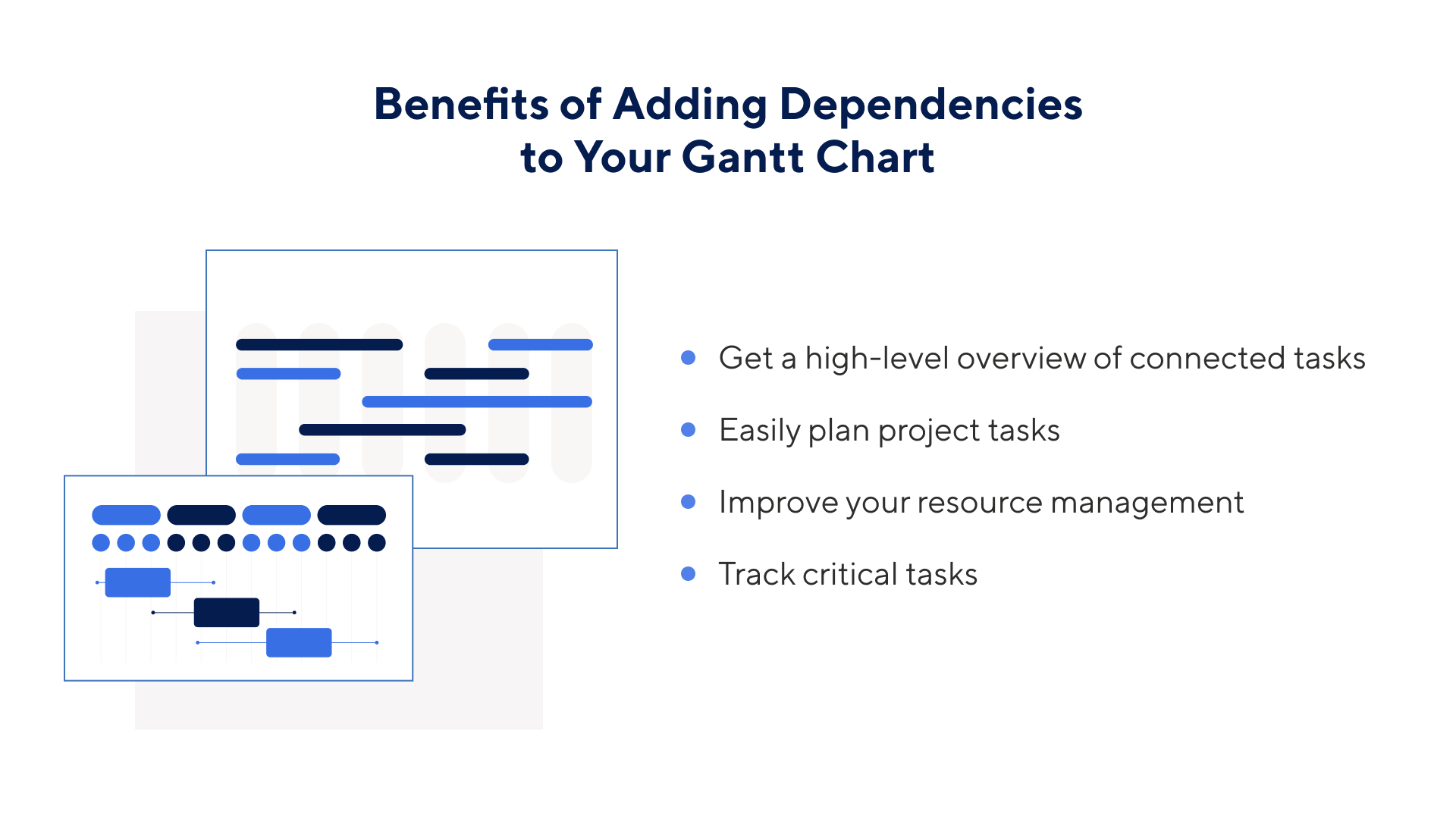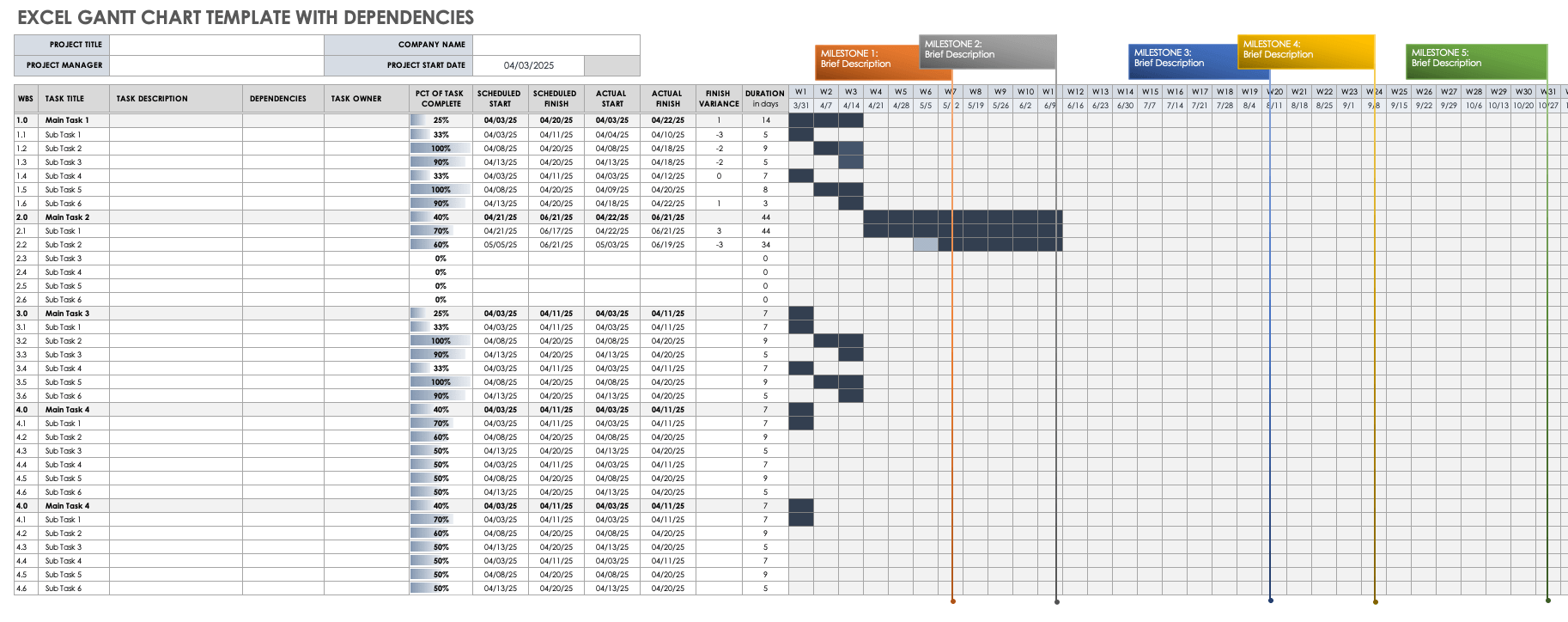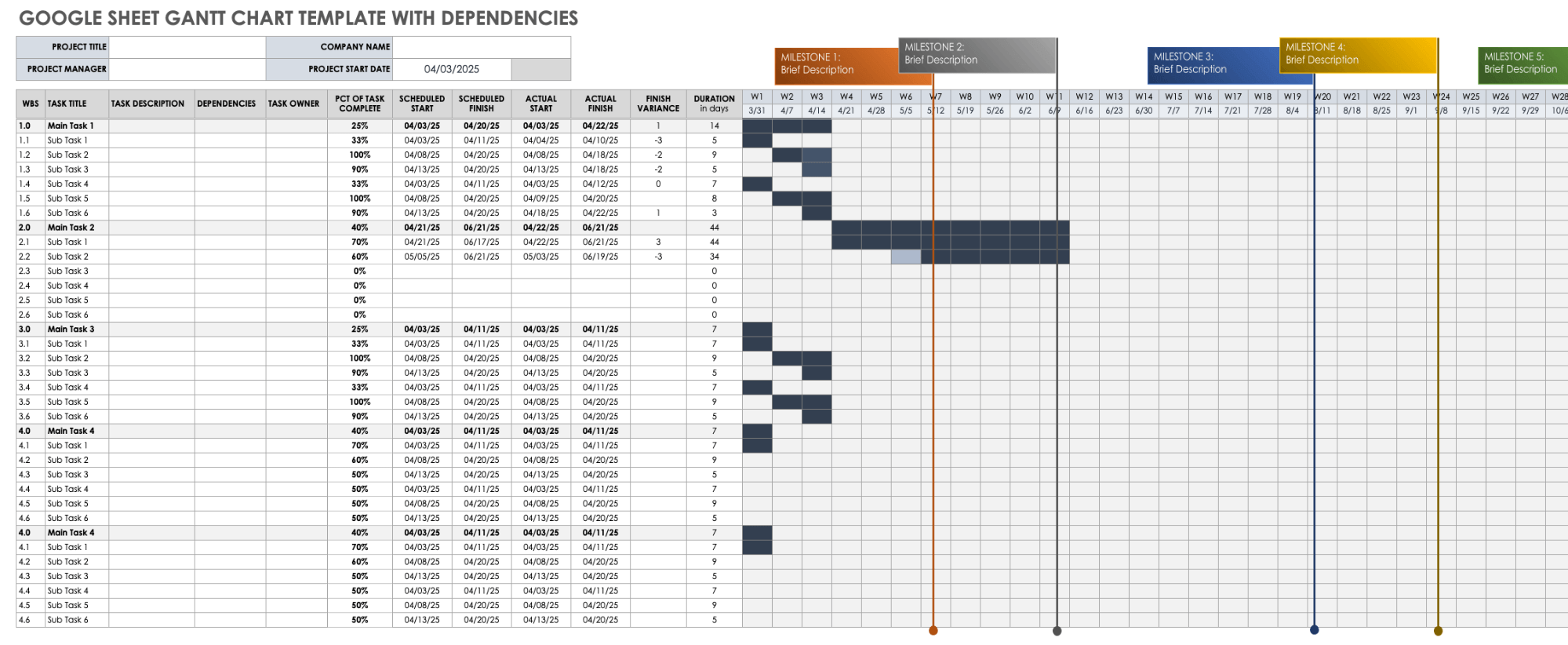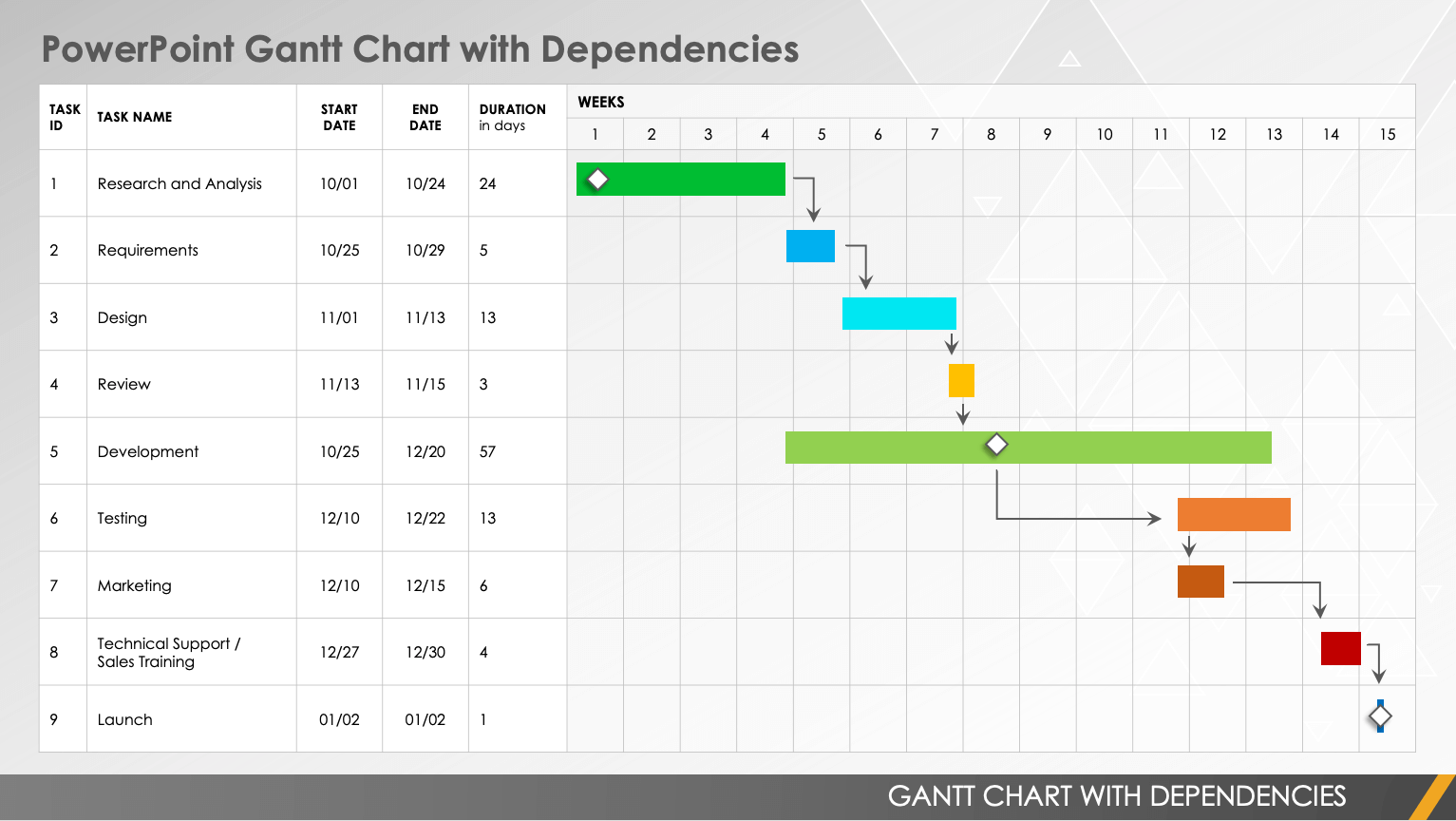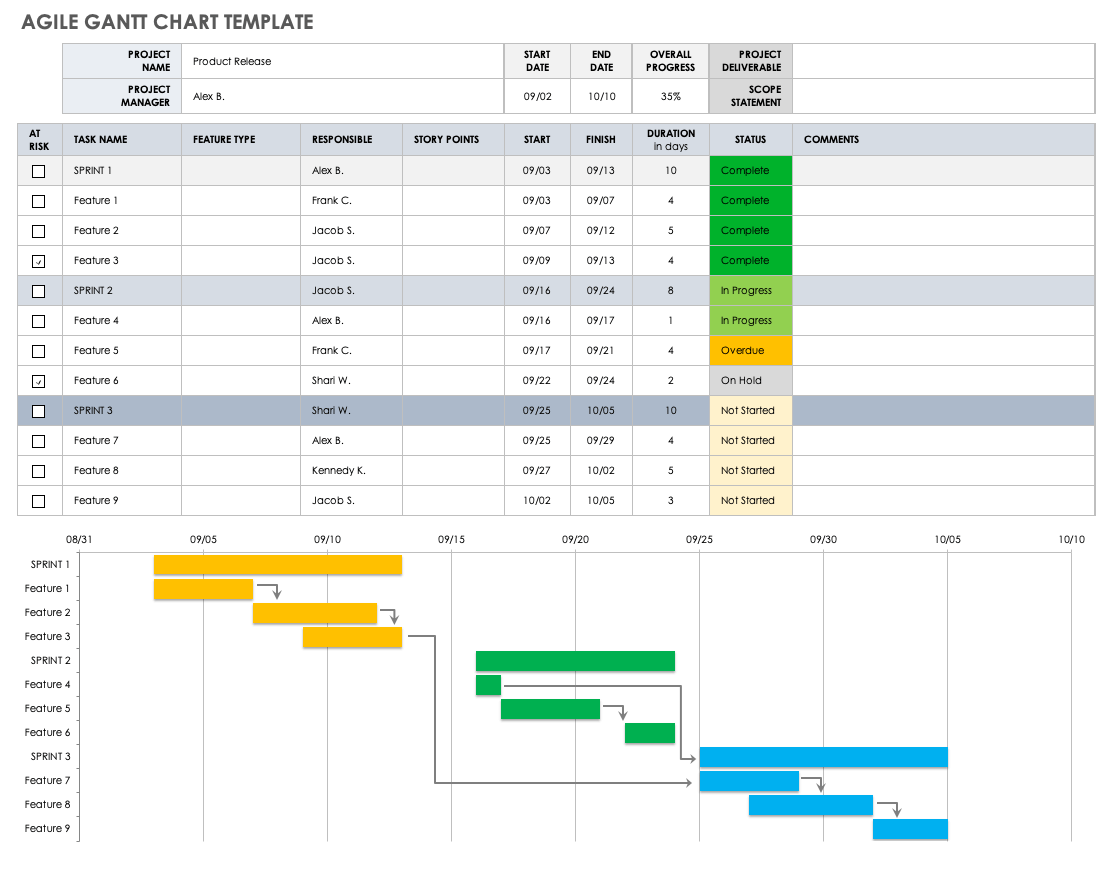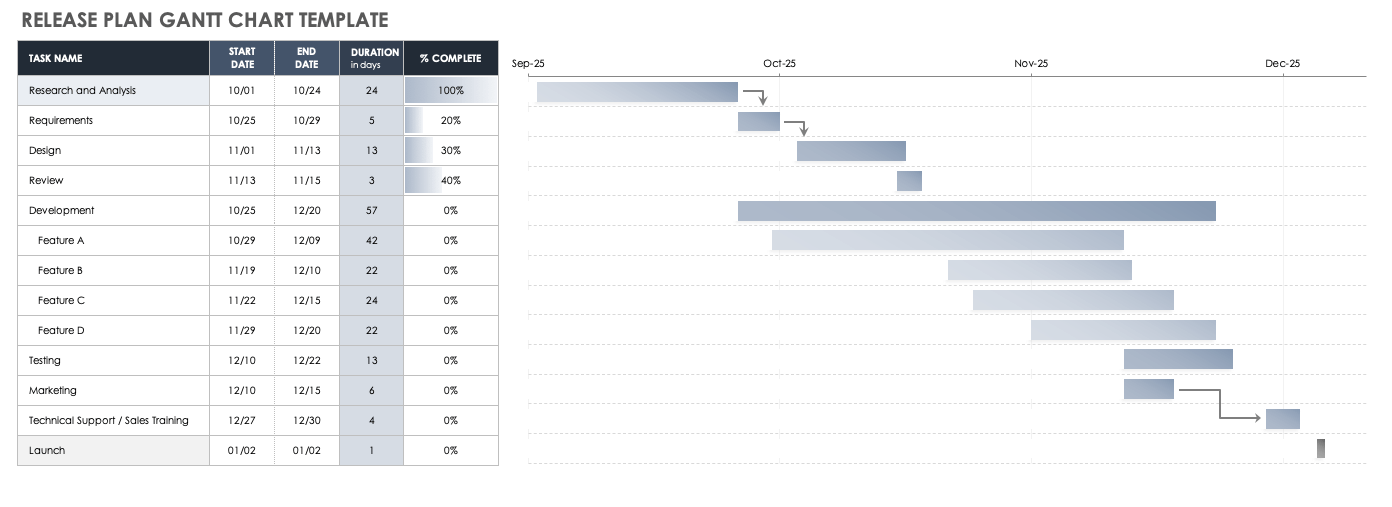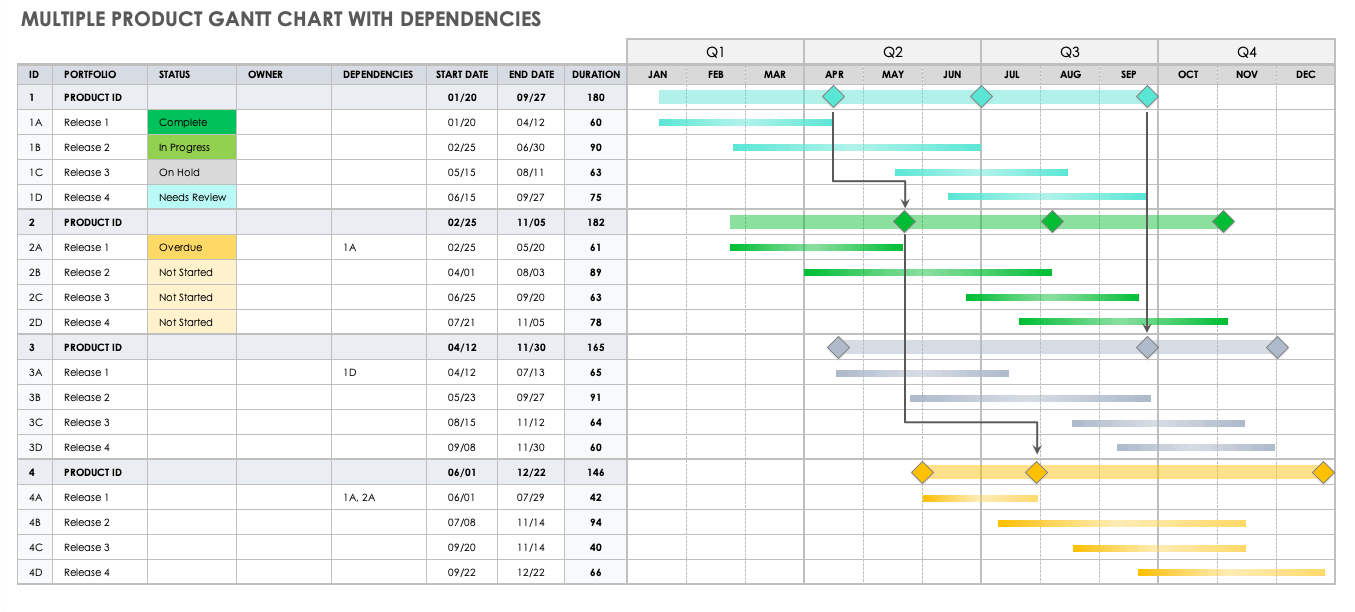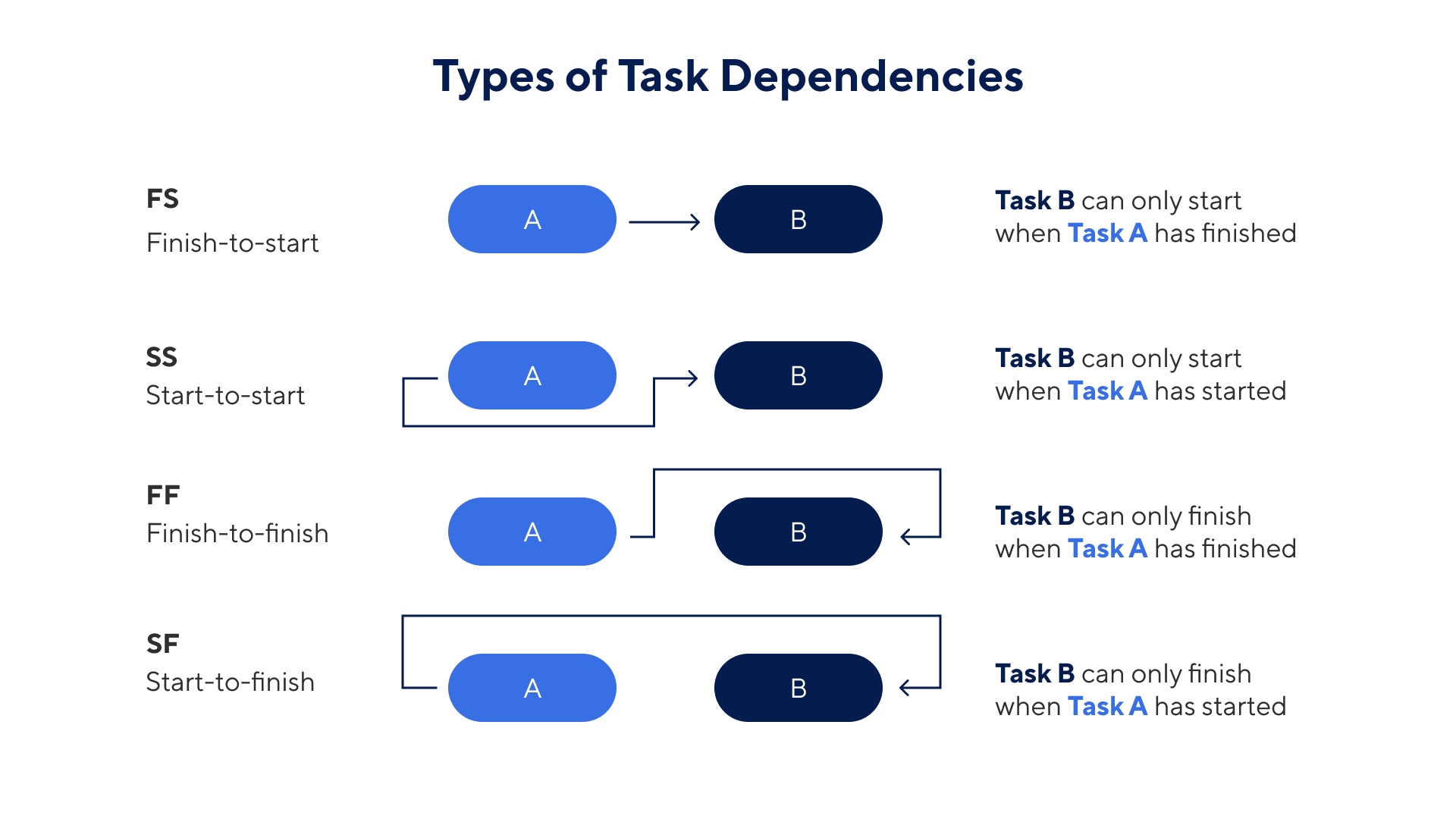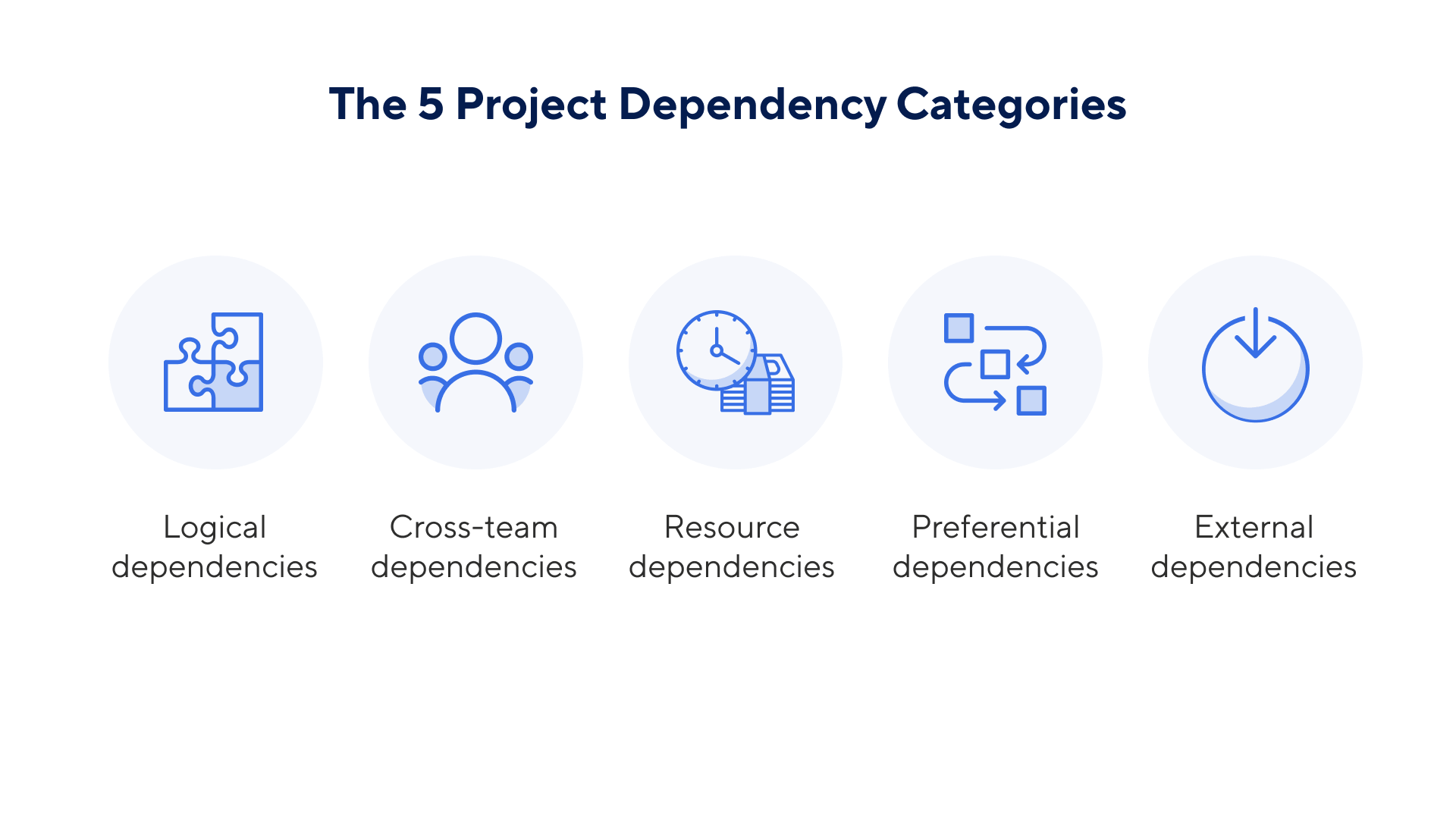Transform your project details into an easy-to-read Gantt chart with Smartsheet

Smartsheet Gantt charts are a powerful tool for project planning, scheduling, and progress tracking. Display tasks across time with horizontal bars, view dependencies between tasks with ease, highlight important milestones, and identify a project's critical path to prioritize essential tasks.
Explore the full range of robust features when you try Smartsheet free for 30 days.
Benefits of Using Gantt Chart Dependencies
The benefits of using a Gantt chart include getting an overview of your connected tasks, the ability to more easily plan and track critical tasks, and improving your resource management.
Let’s take a look at the benefits in a bit more detail:
Let’s look at these benefits in more detail.
- Get a high-level overview of connected tasks: A Gantt chart can help you visualize your dependencies from a top-level perspective. It shows you which tasks are connected without overloading the project manager with too much information.
- Easily plan project tasks: Identifying dependencies puts you in a better position to schedule your work appropriately, as you can see which tasks rely on others.
- Improve your resource management: When you can see which tasks depend on each other, you can make informed decisions about how and when to allocate your resources. For example, if marketing needs to complete a task that another task is dependent on, it makes sense to allocate budget to them first, to make sure that initial task gets done and won’t hold up other items.
- Track critical tasks: With dependencies in place, project teams can easily see if critical tasks are delayed. Teams can spot these delays quickly and get things back on track to hit the deadline.
Now, let’s take a look at some Gantt chart templates that you can use to identify your own project dependencies.
Excel Gantt Chart Template with Dependencies
This comprehensive Gantt chart template includes a work breakdown structure (WBS), which outlines project phases, tasks, dependencies, and milestones. Assign an owner and track progress for each task.
Google Sheets Gantt Template with Dependencies
Manage projects and share progress with stakeholders with this Google Sheets version of Gantt template. The template includes a breakdown of tasks, assigned owners, task dependencies, and task duration. Plan and track project milestones as you move toward meeting your final objectives with this visual Gantt chart.
Download a Gantt Template with Dependencies for Google Sheets
For more Gantt chart templates, including a Scrum project management template with burndown chart, see this complete Google Sheets Gantt chart collection.
PowerPoint Gantt Chart with Dependencies Template
Create a PowerPoint Gantt chart for any project you want to plan, track, and share with stakeholders. Use connecting arrows to highlight dependencies between project tasks, and represent current or completed tasks with different colors or partial shading on the bar chart. This template is ideal for displaying a list of tasks, start and end dates, and the duration for each task as part of a presentation.
Download a PowerPoint Gantt Chart with Dependencies for PowerPoint
Agile Gantt Chart Template
This Agile Gantt chart template is divided into individual sprints to display features, story points, task owners, and project status. Easily track overall progress and view dependencies within each sprint. The Gantt chart provides a snapshot of project planning, which you can update as the team completes each sprint and modifies tasks. An additional comments section supports planning and communication among team members. This template provides the flexibility of an Agile approach with the organization of a Gantt chart.
Download a Agile Gantt Chart Template for
Release Plan Gantt Chart Template
Use this Excel template to manage release planning, from initial research stages to feature development, quality assurance, promotion, and final launch. The template provides a spreadsheet for compiling project data, including timelines for all project activities and current progress for each task. The Gantt chart provides a visual overview of release stages and dependencies between tasks. Edit the template to include each step in your release plan.
Download a Release Plan Gantt Chart Template for
Multiple Product Gantt Chart with Dependencies
Use this basic Gantt chart to track multiple product releases, show the time frame for each product release, and mark dependencies between them. This template is useful for organizing a product portfolio, visualizing deadlines, and tracking release status. Customize the template by adjusting the color scheme or adding columns for additional data.
Download a Multiple Product Gantt Chart with Dependencies Template for
Understanding Task Dependency Types
There are four different types of task dependencies:
Let’s look at these in more detail.
- Finish-to-start (FS): This is the most common type of dependency used in a project plan. It refers to dependencies in which the predecessor task must be completed before the successor task can begin.
- Finish-to-finish (FF): Tasks may run simultaneously with this dependency, but the successor task can’t be completed until the predecessor is complete. For example, if you start inspecting a building while one component is still in progress, you can’t inspect that component until it’s complete.
- Start-to-start (SS): In this case, the successor task can’t start until the predecessor task starts. The tasks may or may not start simultaneously.
- Start-to-finish (SF): Used in rare cases, this dependency indicates that one task can’t finish be finished until another task begins. To put it simply, the predecessor activity must start before the successor activity can finish.
Categories of Project Dependencies
Now that we’ve covered the four types of task dependencies, let’s go over the categories of project dependencies.
There are five different categories of dependencies: logical, cross-team, resource, preferential, and external.
While task dependencies outline how specific tasks relate to each other, project categories focus more on how the dependency works. The categories look at dependencies from a higher level, showing how internal and external factors influence them.
If this sounds confusing, don’t worry. Below, you’ll find more detail about each category, plus some examples to demonstrate how they work. Let’s take a look:
- Logical dependencies: Also known as a causal dependency, a logical dependency is something you can’t avoid in the project. It's crucial to the project's success, and it can't run simultaneously with another task. For this reason, logical dependencies are usually finish-to-start dependencies, where output is required from the previous task for the following task to occur. An example of this is purchasing construction equipment in order for the building team to get to work.
- Cross-team dependencies: As the name suggests, cross-team dependencies are any tasks that rely on the work of more than one team. Product development is a good example, where the development team needs information from the marketing team about customer needs and wants. Therefore, developing the new product is dependent on the marketing team conducting market research and providing it to the development team.
- Resource dependencies: If your project has limited resources, you might have resource dependencies. In short, the term refers to constraints based on the number of available people you have to work on a given task — or, to two or more tasks that need to be completed by the same person. An example could be design work, where the progress of project B is dependent on a graphic designer finishing project A (without being overworked).
- Preferential dependencies: Unlike logical dependencies, preferential dependencies aren’t required for project completion. Instead, they are preferences the team defines and bakes into their project process. As an example, think about a typical approval process, where three different managers need to approve a campaign before it goes live. This process reduces the chance of the campaign going live with any mistakes, but it’s not critical to project delivery, as you can still launch a campaign without approval from all three managers.
- External dependencies: These are dependencies outside of your sphere of control. For example, let’s say you realize the designer tasked to complete project A and project B above doesn’t have the capacity to do both. You need another designer and you ask HR to hire someone in. Your ability to complete the design work in project B is dependent on HR completing the hiring process, but you don’t have control over when that will happen.
How to Create a Gantt Chart in Excel
To get instructions for creating your own template, take a look at our article, “How to Create a Simple Gantt Chart in Any Version of Excel.” You’ll find a clear tutorial with screenshots to illustrate the process.
You can also take a look at this in-depth guide to Gantt Charts to learn more about when, why, and how to use a Gantt chart — as well as the pros and cons of using one. Lastly, check out our guide to creating a simplified Gantt chart.
Tips for Managing Project Dependencies
To set yourself up for success, take a look at some of these best practices for managing project dependencies.
- Identify the type of dependency: Start by identifying the type of dependency you face. This will put you in a stronger position to manage it, ensure you’re on top of what could go wrong, and help you plan how to overcome any of these challenges. Above, you can read through the different types and categories of project dependencies.
- Use the right software: To ensure you have a clear picture of your dependencies, you need a platform that allows you to manage your dependent tasks. This is where using the right project management software comes into play. Online Gantt chart software enables you to easily connect your dependent tasks and even identify the critical path.
- Make your dependencies clear and visual: To easily spot dependencies in your Gantt chart (or any format for that matter), it’s helpful to color-code the tasks. For instance, you might choose to have all your dependent tasks in red and all other tasks in blue. This makes it easier for you to see your dependencies at a glance.
- Continually track dependencies: As the project progresses, you’ll need to continually track your dependencies to make sure things are running as scheduled. A good way to do this is to add percentages to tasks. An online platform will show you how they’re progressing in real-time. If any dependencies are falling behind, you can spot it while it’s happening and figure out how to fix it. As a result, you’ll deliver your project on time.
Easily Track Task Dependencies with Smartsheet for Project Management
From simple task management and project planning to complex resource and portfolio management, Smartsheet helps you improve collaboration and increase work velocity -- empowering you to get more done.
The Smartsheet platform makes it easy to plan, capture, manage, and report on work from anywhere, helping your team be more effective and get more done. Report on key metrics and get real-time visibility into work as it happens with roll-up reports, dashboards, and automated workflows built to keep your team connected and informed.
When teams have clarity into the work getting done, there’s no telling how much more they can accomplish in the same amount of time. Try Smartsheet for free, today.
